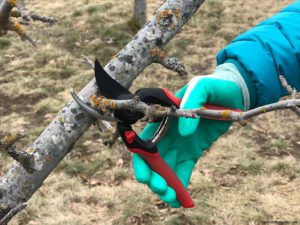March 26 Column: Spring Pruning

Who’s anxious to really get going in their gardens? Boy, I sure am! Once our snow melted, it became very apparent that I’ve got a whole lot of catching up to do. In my column today, I discuss the types of spring pruning we’ll be doing and the timing of them.
Here’s a link to my column in today’s edition of The Spokesman-Review: Pruning not that difficult if you allow the plant to guide you. (or you can read my garden column lower in this post)
With all pruning, you want to remove…
- Dead and damaged branches.
- Crossing branches.
- Branches that grow through the middle of plant.
Once you’ve taken care of them, you just might be done. Or perhaps you have a little bit of tidying up to do to rein in a plant’s growth or remove problematic branches. You’ll learn much more in my column.
This week’s video:
I also filmed a video showing you how I take care of winter damage to arborvitaes. I’ll also cover how to prune shrub-type berries. These include currants, blueberries, gooseberries and jostaberries. And, of course, I’ll discuss roses, raspberries and fruit trees. Whew! And somehow, I squeezed all that into 4 1/2 minutes!
I forgot to mention something while talking about pruning roses. When you’re just shortening a cane (or removing a damaged part from a cane), make your cut just above an outward-facing bud. That way, the new growth will be heading out from the plant rather than through the middle.
Spring Pruning garden column:
by Susan Mulvihill
Is it just me, or are you feeling behind in your springtime chores, too?
After what seemed like the longest winter in history, it’s wonderful to finally be done with the snow. Now that it’s gone, there’s no escaping the many outdoor projects that need to be tackled. At the top of my list is pruning some of our trees, shrubs and roses. I fear the weight of the snow for months on end and occasional polar blasts may have caused a bit of damage.
Start slowly
Pruning is not all that difficult if you approach it in an orderly fashion. You’ll actually find each plant will guide you through the process by following a few steps.
Before beginning, take a good look at your tree or shrub. Do you see broken branches? Those should come off first. Next, look for any dead or diseased branches and remove them as well.
Look for branches that cross or those growing through the center of the plant. They will need to be removed but don’t rush the job. Take your time before deciding which branch, or branches, need to come off. Just like with cutting hair, you can cut off a branch but you can’t put it back if you change your mind.
At this point, stand back and take a look at the tree or shrub you’re working on to determine if some remedial pruning is warranted. For example, if it’s a tree, is there a branch that smacks you every time you mow the lawn? Maybe it needs to be removed.
Make all of the above cuts close to the trunk or main stem, without leaving stubs behind. There’s no need to use pruning paint as plants are able to heal themselves naturally.
Pruning flowering shrubs
Flowering shrubs require some extra thought before picking up the pruners because you need to know when they bloom. Those that bloom before mid-June — including forsythia, lilac, kerria, weigela and early-blooming viburnums — should be pruned as soon as they’ve finished blooming.
Shrubs that bloom later in the summer or fall can be pruned in late winter or early spring. That’s because they bloom on new wood. Examples of these include butterfly bush (Buddleia), rose of Sharon, bluebeard (Caryopteris), potentilla and spirea.
You’ll notice I haven’t mentioned hydrangeas yet. Because there are different types that bloom at different times of the year, it’s important to know which one you have.
The bigleaf (H. macrophylla) and oakleaf hydrangeas (H. quercifolia) bloom on old wood so they should be pruned right after they bloom. Smooth hydrangeas (H. aborescens) and panicle hydrangeas (H. paniculata) bloom on new wood, which means the safe time to prune them is late winter or early spring to encourage new growth.
Clematis vines are divided into groups based on when they bloom. Prune spring-bloomers right after they’ve finished blooming. Summer-bloomers can be pruned in early spring. Vines that bloom on new wood should be trimmed to the ground before new growth begins. If you don’t know which kind you have, skip pruning this year and see when they bloom.
Last but not least, don’t try to do all of your pruning chores in a single day. This will give you a nasty case of tendonitis so remember to pace yourself. Many shrubs don’t require annual pruning, so only work on them if they have broken, diseased or crossing branches. That just might save you some unnecessary work.

